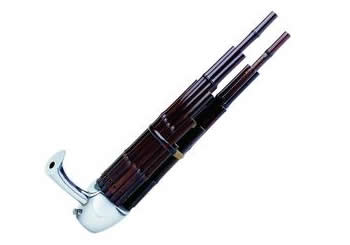Silk and Traditional Chinese Musical Instruments
Silk is the traditional material used in construction of strings.The Liji (Record of Rituals, c. Ist century BC) suggests that silkstrings represent 'puri- ty'(lian) and 'determination' (zhi), an indication of the high value assigned by Confucian scholars to stringed instruments. During the ancient period, various zither types were differentiated,most significantly the scholar's qin,the ceremo- nial se, and the popular zheng. The qin is a small bridgeless seven-string zither, the paramount instrument of the Confucian scholar. The se is a larger zither,an exclusively ritual instrument,with twenty-five strings and movable bridges. These two zithers have been treated as a symbolic pair since their earliest docu- mentation.The Shijing,for example,says of a happy marriage,'good harmony between wife and husband is like playing the se and qin'. Indeed, this metaphor is current today, though usually stated in reference to a failed marriage:'the qin and se are not in harmony'! Another related association with the Confucian value system is found in the Lijit 'the virtuous man zhunzi, upon hearing the sound of the qin and se,thinks he is a very good person'. For the qin itself, which would become one of the most important of Chinese classical instru- ments,many other zoomorphic and cosmological associations emerged as well.
A very different perspective emerged for the zheng.Smaller than the large se,the zheng during its formative period existed in both twelve-string and thir- teen-string varieties .That the zhieng was a 'popular' instrument from the beginning is apparent fromits omission from the ritual ensemble.Its etymology is revealing of the low social position this instrument was assigned,for its written character was derived from (and forever associated with) the ancient and inglorious ideogram for "struggle' (rather than, say, with the positive values of 'harmony','reverence', or 'fer- tility'). As a consequence of this negative association, an invention myth e- merged:in a 'struggle' between two people over a twenty-five-string se,the se was broken into two halves,resulting in the emergence of one zheng with twelve strings and another with thirteen. While this explanation is believed to be apocryphal, it is still very widely repeated today.



